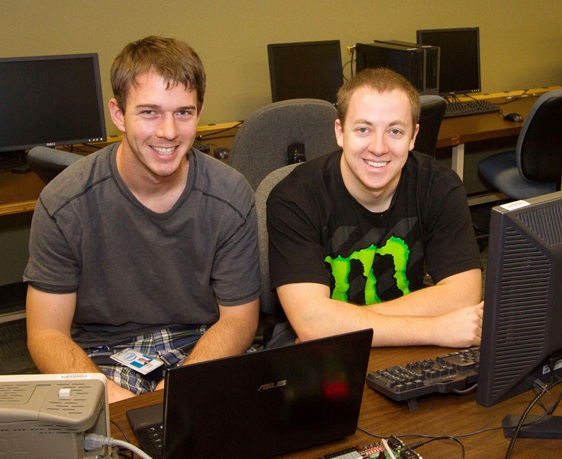
Competition gives students glimpse of industry’s computer software engineering challenges

ASU computer systems engineering students Larry Hunt (left) and Steven Caporaso took a first-place prize in a recent computer software testing competition. Photo: Jessica Slater/ASU
Posted December 11. 2012
Three years ago a job-recruiting event at Arizona State University attracted an executive and an engineer with the Progressive company – one of the largest auto insurers in the United States – who came in search of students skilled in computer software testing.
“At the time we were working to restructure our software engineering courses and strengthen the software engineering concentration” within the computer science curriculum, says professor Yann -Hang Lee.
Lee is chair of the computer science and engineering program for the School of Computing, Informatics, and Decision Systems Engineering, one of ASU’s Ira A. Fulton Schools of Engineering.
With an ever-growing amount of data and web-based operations to manage, software expertise “is the backbone of Progressive’s business. They use some of the most advanced web software services,” Lee says.
So with a common interest in seeing more students acquire advanced education in the software field, Lee and his colleagues teamed with Progressive representatives to develop a new upper-level software quality assurance and testing course.
The collaboration has led to Progressive sponsoring software engineering workshops and computer programming competitions for ASU students, as well as supporting activities of student organization in recent years.
Over that time the company has hired several ASU computer science and engineering students for internships and full-time software engineering jobs.
The most recent joint effort with Progressive arose from a Software Testing Summit conducted by the company and attended by James Collofello, associate dean of Academic and Student Affairs for the engineering schools, and computer science and engineering lecturer Janaka Balasooriya.
Discussion at the gathering focused on how software testing practices that meet industry expectations could be incorporated into computer science and computer systems engineering curriculum.
Collefello proposed the idea of a student software testing contest as a step in that direction. Balasooriya worked with Progressive to organize it.
It pitted a select group of ASU engineering students in two-person teams against each other in a software testing competition. Of almost 60 students who applied to participate, 26 were chosen – making up 10 teams of undergraduate students and three teams of graduate students.
They were given about an hour to demonstrate skills at identifying bugs and potential problems in computer programs, testing the validation logic in numbers sequences and finding defects in the visual user-interface features on a web page.
Students Larry Hunt and Steven Caporaso took the first-place prize of $250 in the undergraduate division.
Winning the competition “was a confidence-building experience,” Hunt said, and it gave him and Caporosa a good gauge of their skills compared to fellow students, as well as a better understanding of the level of expertise the software industry is demanding of its workforce.
The prize – a $250 electronics-store gift card – was also a motivation, they added.
A second-place undergraduate prize worth $125 went to David Taylor and James Huffman. Makram Jazrawi and Qingyun Li won a $75-value third-place prize. Marthony Tagunod and Beejal Shah, and the team of Mark Dickinson and Jakob Booker earned $50-value prizes.
The $250-value graduate student competition prize was won by Abhilash Karanam and Deepthi Jyothi.
Karanam said being challenged to find solutions to computer software problems they had never before encountered while working under the time pressure of a competition “was an interesting way for us to assess our skill levels. It taught us to think about problems and solutions in different ways.”
The teams “showed a lot of energy and enthusiasm in performing the tests, and most of them were successful in finding the major bugs by applying their computer science, math and problem-solving skills,” Balasooriya said.
Students got a good perspective on the kinds of complex challenges being faced in today’s fast-changing software field, Balasooriya said, and the competition “helped them to learn about the level of expertise they must acquire” to compete for jobs in the computing and software industries.
Media Contact:
Joe Kullman, [email protected]
(480) 965-8122
Ira A. Fulton Schools of Engineering



































